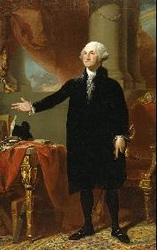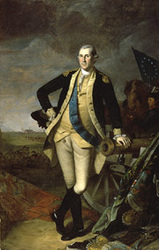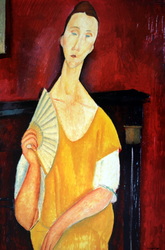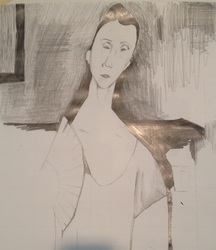|
"Breathe"... "BREATHE"... "BREEEEEATHE"...
This is how Anthony Fitzpatrick of Achieve NJ and The Department of Education started his presentation on SGO's at the AENJ conference. Ever since I left that room, breathing is far from my mind when thinking about SGO's. If you've been playing along, you read a few weeks ago that I wrote the SGO's for my middle school art department and I was all proud of what I'd done. I felt that I had written a prompt that would give us a true understanding of what our students really thought about ART. Little did I know then, I had made myself an impossible assessment to assess. So now I'm left in a maze trying to figure out just what I want to assess that is actually assessment worthy. Fitzpatrick suggested we think about our SGO's as standards based and narrow down the process by identifying the key content knowledge we want our students to walk away with. THIS IS A CHALLENGE. My curriculum is based on a thematic approach to art education where students are using artmaking to learn about themselves, to express memories, to understand their environment... Add to this, our middle school art courses are all survey based - exploring everything from the art elements and principles of design to art history to contemporary art making practices and let's not even get started on the variety of materials and techniques we address! I'm currently considering using a cumulative portfolio assessment as my SGO. But, I'm not sure what exactly I want to look for in that portfolio. Is my goal "drawing skills"? Is my goal "use of color"? Is my goal "understanding of human proportion"? I just don't know! And, even if my goal is one of those things, I'm not quite sure how to write a cumulative rubric that addresses a portfolio assessment. SIGH... If you've been reading silently from afar, now's the time to step out of the shadows and chime in with your thoughts. Are you writing SGO's? What are you doing? Art is such a specialized area and assessment in this content area is not as straight forward as a test. Let's collaborate here and help each other keep the state happy. Go on, you know you want to comment!
0 Comments
One of my favorite activities of each school year is a collaborative collage that I commonly refer to as "The Group Draw". I can't take credit for the idea - my first experience with a Group Draw was in graduate school during a summer studio program at Boston University. The activity uses simple materials but teaches students big lessons. Materials: Large white paper black tempera paint black masking tape elmer's glue (Stuff I had even though I do not have my new supplies) Procedure: Each student paints a sheet of white paper using patterns of their own choosing. Each painting is torn into 3 pieces. A large sheet of white paper (from a roll) is placed on the floor and the torn pieces of each students' painting are placed around the outside edge. Torn pieces are glued in place. Students discuss the result and decide whether to add more paint or to cut and reposition the pieces of the collage. As a collaborative group, the students work together to decide to add paint, cut and reposition, or cut and add more white paper to the piece. This process continues until the group is satisfied with the results. So, what do we learn from this? First, students learn that nothing is precious. There is always one student who does not want to rip his or her paper. That student always feels that they have created a painting worth keeping "as is". There are also always students who feel the piece is "done" before the group agrees to stop. They don't want to change the piece because they feel it is great "as is".By forcing the students to change their work repeatedly, they learn that nothing is so precious that it cannot be altered. By the end of the activity, students almost always feel that it is always possible to make changes to a piece of art without ruining the piece. Second, the students learn to work as a group and respect the views of one another. They learn to listen to differing opinions and express their thoughts to the class. They learn to explain their reasoning to others in a way that makes their vision clear to the group. Lastly, the students learn to see art in a new way. Many students in middle school have a very concrete view of what art can be. This activity allows students to explore the world of non-objective art in a non-threatening way. By working as a group, students are able to respond to shapes and patterns produced by others without feeling the overwhelming urge to make "something" from the marks. The collaborative nature of this activity helps students to remove the personal pressure they often feel to make art "right". The results of this activity vary from year to year but I always enjoy reading the student responses to the process. There are always "ah-ha" moments where students start to comprehend the idea that art is part experience and part product. This realization is one that helps the students to loosen up a bit in the art room and realize that sometimes what you learn from the experience is more important than the final product. Over the years I have made it a priority to reinvest in my teaching practice by attending workshops, seminars, conferences and classes that relate to art education. Sometimes these professional development opportunities are theoretical and other times they are materials based. This week, I am attending the Summer Academy for Teachers at the Pennsylvania Academy of Fine Arts (PAFA). If you are unfamiliar with PAFA and their offerings, I urge you to visit their website for more information. The focus of this year's program revolves around the museum's collection of historical American paintings. I saw this as a chance to learn some new approaches to teaching art history, collaborate with other art educators, and spend some time being inspired and making art (the program leans heavily on art making - yay!). I also felt this was a great opportunity to expand my knowledge of this genre of art history - our 8th grade Social Studies Curriculum focuses on American History and I try to collaborate within my building as much as possible. Today we started the day with a brief tour of the museum. Our guide refreshed our understanding of Visual Thinking Strategies (VST) using Benjamin West's monumental painting, Death on the Pale Horse. VST is a great technique for looking at art with children because there are no wrong answers. VST is also an invaluable tool for today's learner as it helps to increase visual literacy. We also spent some time comparing and contrasting two of the museum's portraits of George Washington. In the afternoon, we visited the studios and began work on a grid enlargement drawing. This may sound odd and you may be asking yourself, "what art teacher doesn't know how to do this?" Well, you are correct, and I would bet that ALL art teachers know how to do this and have taught their students using grid enlargement at some point during their career. However, PAFA's summer academy is open to any TEACHER, thus not all of the participants are working as art educators.
I chose to work from Modigliani's La femme a l'eventail. Having three hours of uninterrupted time to draw was glorious. This is a luxury I do not often allow myself and I found the experience to be refreshing and inspiring. I'm not quite finished, but you can see the progress and the resemblance. I increased the image size by 2.5 - the drawing is 15 by 23.75 inches. |
Lora DurrMiddle School Art Educator. Adjunct Art Education Professor. Non-Profit Arts Organization Board Member. Artist. Arts Advocate. Dog-Mom. CrossFit Enthusiast. Archives
October 2015
Categories
All
Other BLogging Art EducatorsThe Art of Education
The Luminous Page The Teaching Palette That Little Art Teacher Art Teachers Hate Glitter Adventures of an Art Teacher Mrs. Art Teacher Art with Mr. E Art is Basic Art Makes Kids Smart And, if you want more... visit Artists in Blogland for a full directory of art teacher blogs! |





 RSS Feed
RSS Feed


